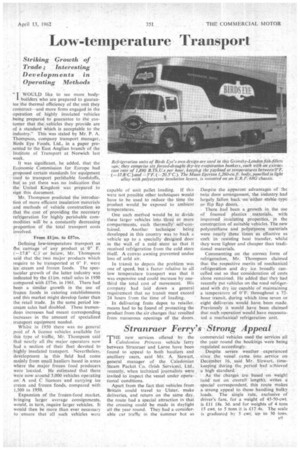Low-temperature Transport
Page 43

If you've noticed an error in this article please click here to report it so we can fix it.
Striking Growth of Trade; Interesting Developments in Operating Methods
" WOULD like to see more body ' builders who are prepared to guarantee the thermal efficiency of the unit they construct—and more firms engaged in the operation of highly insulated vehicles being prepared to guarantee to the customer that the .vehicles they provide are of a. standard which is acceptable to the industry." This was stated by Mr. P. A. Thompson, company transport manager, Birds Eye Foods, Ltd., in a paper presented to the East Anglian branch of the Institute of Transport at Norwich last week.
It was significant, he added, that the Economic Commission for Europe had proposed certain standards for equipment used to transport perishable foodstuffs, but as yet there was no indication that the!l United Kingdom was prepared to sign this document. •
Mr. Thompson predicted the introduction of more efficient insulation materials and methods of vehicle construction so that the cost of providing the necessary refrigeration for highly perishable commodities will be a constantly decreasing proportion of the total transport costs involved.
From Ulm. to £57m.
Defining low-temperature transport as the carriage of any product at .0° F.. (-17:8 C.).or below, Mr. Thompson said that the two major products which require to be transported at 0' F. were ice cream and frozen foods. The spectacular growth of the latter industry was
indicated by the retail sales in 1950 compared with £57in. in 1961. There had been a similar growth in the use of frozen foods in catering establishments and this market might develop faster than the retail trade. In the same period icecream sales had doubled. These tremendous increases had meant corresponding increases in the amount of specialized transport equipment needed.
Whilst. in 1950 there was no general pool of A licence vehicles available for this type of traffic, Mr. Thompson said that nearly all the major operators now had a section of their fleet devoted to .highly insulated transport. Nevertheless, development in this field had come mainly from small hauliers based in areas where the major frozen food producers were located. He estimated that there Were now around 5.000 vehicles operating on A and C licences' and carrying ice cream and frozen foods, compared with t,500 in 1950.
Expansion of the frozen-food market. bringing larger average consignments, would, in turn, require larger vehicles. It woUld then be more than ever necessary to !ensure that all such vehicles were capable of unit pallet loading. If this were not possible other techniques would have to be used to reduce the time the product would be exposed to ambient temperatures.
One such method would he to divide these larger vehicles into three or more compartments, each thermally. self-contained. Another technique being developed in this country was to back a vehicle up to a specially designed door in the wall of a cold: store so that it received refrigeration from the cold store itself. A canvas awning prevented undue loss of cold air.
In transit to depots the problem was one of speed, but a factor relative to all low temperature transport was that it was expensive and could increase by onethird the total cost of movement. His company had laid down a general requirement that no transit must exceed 24 hours from the time of loading.
In delivering from depot to retailer, means had to be found of protecting the product from the air changes that resulted from numerous openings of the doors. Despite the apparentadvantages of the twin door arrangement, the industry had largely fallen back aon'either stable type or flip flap doors.
There had been a growth in the use of foamed' plastics materials, with improved insulating properties, in the construction of suitable vehicles. The new polyurethane and polystyrene materials were nearly 'three firnes as effective as cork 'in resisting heat transfer, whilst they were lighter and cheaper than traditional materials.
Commenting on the correct form of refrigeration, Mr. Thompson claimed that the respective merits of mechanical refrigeration and dry ice broadly cancelled out so that consideration of costs alone remained. He added that they had recently put vehicles on the road refrigerated with dry ice capable of maintaining a temperature of 0°F. throughout a 72hour transit, during which time seven or eight deliveries would have been made. Previously it would have been claimed that such operation would have necessitated a mechanical refrigeration unit.




















































































































